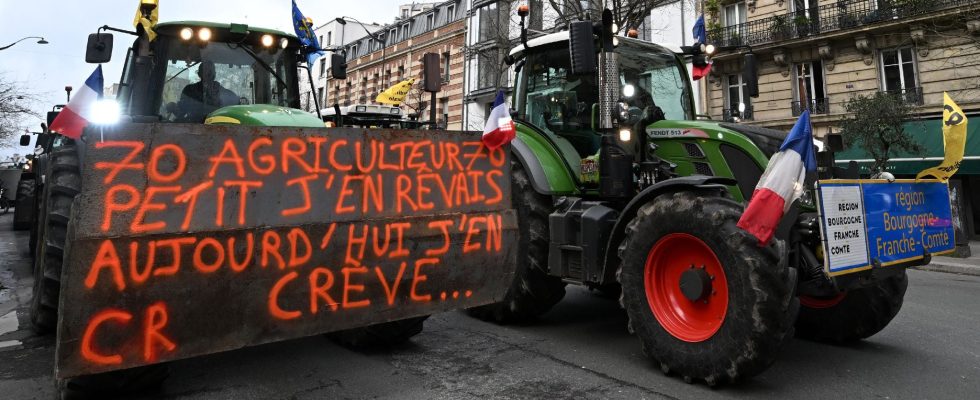“Over-indebtedness”. At the Salon de l’Agriculture, the word comes up again and again among farmers. During the improvised exchange by the head of state, one of them mentions his friend who committed suicide. He couldn’t do it anymore. Registered letters were piling up in his mailbox. Unpaid debts too. On February 16, it was Delphine Serreau, a goat breeder in Indre, who came to Paris to ask the authorities for help. After parking in front of the Elysée, she was received at the Ministry of Agriculture. This forty-year-old needed 135,000 euros to try to save her business and her 80 goats.
Unsurprisingly, farmers are among the professions most affected by over-indebtedness, that is to say excessive debt that becomes difficult to repay. On its website, the movement Peasant solidarity, which reaches out to farmers in distress, recalls: “Borrowing to set up or develop your farm, in reasonable proportions and compatible with the expected cash flow, is necessary and often essential.” In 2021, more than 40% of French farms are in debt, compared to 11% on average for the 11 European countries taken into account in the annual survey of Agricultural Accounting Information Network (Rica).
For what amount? Still the same year, the debt of agricultural holdings reached on average 204,330 euros, a value up 1.3% compared to 2020, according to the Agreste, the statistics and forecasting service of the Ministry of Agriculture. For comparison, this figure amounted to an average of 50,000 euros in 1980. For its part, the Permanent Assembly of Chambers of Agriculture (ACPA) sets the debt rate at 193,000 euros per farm.
A heterogeneous situation
According to Crédit Agricole’s results over the past ten years, the annual level of loans to the agricultural sector exceeds 7 billion euros. In 2022, it even amounted to 9.3 billion euros, an increase of 13% compared to 2021. Note that these loans often run over several decades, increasing the burden on the principal concerned. In detail, “long or medium-term loans, intended to finance investments and working capital of farms, constitute on average 65.7% of total debt (stable ratio compared to 2020)”, underlines the Agreste.
Where does this money go? Breeders must invest in equipment and animal feed. On the cereal side, these are seeds and agricultural machinery. The construction of a building also justifies a large loan. Except that the job can experience several hazards: a tractor to repair, a heatwave that roasts the crops or even a sick cow that we have to slaughter – then buy another one. So many factors which can plunge the farmer into a situation of over-indebtedness. It should also be noted that farmers are linked to the time lag: they are tempted to invest if the harvest was good; and when the following year is bad, the new loan proves difficult to honor.
Still according to Agreste, there are disparities between farmers: “The level of farm debt is less than €50,000 for 27.7% of farms and exceeds €300,000 for 20.7% of them. ” Thus, pig farms are 4.3 times more indebted (€505,570) than sheep-goat farms (€118,940).
But be careful: the pork sector is also the most profitable in French agriculture, behind viticulture. In other words, loans are repaid more quickly. This is not the case for all sectors. Sheep or goat breeders, for example, have an average income six times lower than that of their pig colleagues. This is the difference between indebtedness (borrowing to repay) and over-indebtedness (repaying and accumulating social debts and no longer being able to pay your suppliers).
Furthermore, the debt ratio logically depends on the age of the farmer and the life cycle of the farm. “A farm whose head is under 40 years old, resorting to borrowing to finance the investments necessary for its installation, is in debt to the tune of €270,970 on average: this is almost double compared to a farm whose head is over 60 years old, who has generally written off a significant part of his assets”, specifies Agreste.
A tractor costs more than 300,000 euros
How do we end up having to repay such amounts? In the agricultural sector, the financial counters quickly panic, because the initial loans are considerable. Starting with the equipment: it takes 300,000 euros for a tractor or more than 350,000 euros for a combine harvester. An ultra-sophisticated tractor can cost double that, 600,000 euros. Given the farmer’s income, only credits can be used to purchase them.
By investing in large machines, we focus on better productivity. At the risk of having your eyes bigger than your stomach. “Sometimes, when the financial situation is complicated, we realize that there are too many tractors, or that they are too powerful compared to needs,” observes Sandrine Collet, accountant at Altonéo (Mayenne) and member from Agiragri, in the specialized media For the Eco.
It is therefore to avoid over-indebtedness that farmers are talking about reducing their production costs, with better valorization of their production. At the Salon de l’Agriculture, some called for a blank year for 2024. This would involve suspending current credits given the scale of the crisis. This is what Rural Coordination is demanding, but the executive refuses. One thing is certain: the problem of over-indebtedness in the agricultural world is not new. Already, in 2001, Joseph Colombani, nationalist president of the Haute-Corse federation of the FNSEA, warned in the void on this subject: “We are on a powder keg.” A phrase that is still relevant today.
